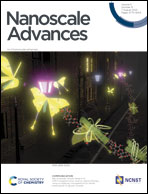Chelate-functionalized magnetic micelles for sequestration of cisplatin†
Abstract
Many cancer patients suffer permanent hearing loss due to accumulation of ototoxic cisplatin in the inner ear. In this study, two types of 100 nm magnetic micelles were developed to sequester cisplatin from aqueous solutions, with the goal of eliminating cochlear ototoxins via magnetic microsurgery. The micellar surface was quantitatively functionalized with anionic S-rich ligands and the micelle core encapsulated superparamagnetic iron oxide nanoparticles. Exceptionally effective sequestration is demonstrated, with removal of greater than 95 and 50% of solution Pt, by means of centrifugal filtration and magnetic extraction. Attraction between negatively charged micellar surfaces and cationic Pt-species played a critical role and was only partially screened by physiologic salt solution. Importantly, magnetic micelles introduce negligible impact on the integrity of inner ear hair cells, demonstrating excellent biocompatibility. This study showcases successful magnetic sequestration of Pt-based ototoxins using highly applicable nano-micellar materials. More generally, these examples highlight features of the micelle-water interfacial environment that are important in developing nanomaterials for metallo-medicinal applications.



 Please wait while we load your content...
Please wait while we load your content...